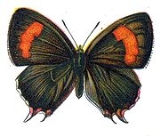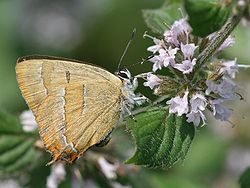
Brown Hairstreak
Encyclopedia
The Brown Hairstreak is a butterfly
in the family Lycaenidae
. The range includes most of the Palaearctic.
 A pretty little butterfly that is found along hedges, scrub, and wood edges but is often overlooked since it spends much of its time high in the tree canopy. Like the Purple Emperor this butterfly uses 'master trees', usually European Ash
A pretty little butterfly that is found along hedges, scrub, and wood edges but is often overlooked since it spends much of its time high in the tree canopy. Like the Purple Emperor this butterfly uses 'master trees', usually European Ash
Fraxinus excelsior. Males and unmated females congregate at the tops of isolated trees. Once mated the female descends to lower levels to begin laying her eggs. males rarely descend and both feed mainly on honey dew
. Both sexes are dark brown on the upperside with orange tails. The female also has a bright orange band across both forwings. The undersides are similar in both sexes and are bright orange with two white streaks.
Prunus spinosa in late August which overwinter, hatching the following spring when the buds are breaking. It has been found that the best way to find breeding sites for this species is to look for the conspicuous white eggs in the winter. The larvae are extremely well camouflaged and feed only at night, remaining motionless during the day. Pupation takes place in leaf litter on the ground in late June or early July and are attractive to ants who will bury them in shallow cells.
Butterfly
A butterfly is a mainly day-flying insect of the order Lepidoptera, which includes the butterflies and moths. Like other holometabolous insects, the butterfly's life cycle consists of four parts: egg, larva, pupa and adult. Most species are diurnal. Butterflies have large, often brightly coloured...
in the family Lycaenidae
Lycaenidae
The Lycaenidae are the second-largest family of butterflies, with about 6000 species worldwide, whose members are also called gossamer-winged butterflies...
. The range includes most of the Palaearctic.
Subspecies
- T. b. betulae Europe, N.Caucasus, Saur, Tarbagatai, Dzhungarsky Alatau, Siberia, Amur, Ussuri. Larva on Prunus spinosa, (Caucasus) Crataegus sanguinea, (S.Altai,Saur)
- T. b. crassa LeechJohn Henry LeechJohn Henry Leech John Henry Leech John Henry Leech (5 December 1862- 29 December 1900, Salisbury was an English entomologist who specialised in Lepidoptera and Coleoptera.His collections from China , Japan and Kashmir are in the Natural History Museum , London.These contain also insects from...
, 1894 S.Ussuri Larva on Padus asiaticaPrunoideaeAmygdaloideae is a subfamily within the flowering plant family Rosaceae. It was formerly considered by some authors to be separate from Rosaceae, and the family names Prunaceae and Amygdalaceae have been used. Commercially, important members of the Amygdaloideae include plum, cherry, apricot,...
, Armeniaca mandschuricaPrunusPrunus is a genus of trees and shrubs, which includes the plums, cherries, peaches, apricots and almonds. There are around 430 species spread throughout the northern temperate regions of the globe. Many members of the genus are widely cultivated for fruit and ornament.-Botany:Members of the genus... - T. b. ongodai Tutt Altai
- T. b. coreana (NireNire Kagenori-External links:* - Notes :...
, 1919) Korea Larva on FabaceaeFabaceaeThe Fabaceae or Leguminosae, commonly known as the legume, pea, or bean family, is a large and economically important family of flowering plants. The group is the third largest land plant family, behind only the Orchidaceae and Asteraceae, with 730 genera and over 19,400 species... - T. b. elwesi Leech, 1890 West China, Central China
- T. b. yiliguozigounae Huang & Murayama, 1992 China
Appearance and behaviour

European Ash
Fraxinus excelsior , is a species of Fraxinus native to most of Europe with the exception of northern Scandinavia and southern Iberia, and also southwestern Asia from northern Turkey east to the Caucasus and Alborz mountains...
Fraxinus excelsior. Males and unmated females congregate at the tops of isolated trees. Once mated the female descends to lower levels to begin laying her eggs. males rarely descend and both feed mainly on honey dew
Honeydew (secretion)
Honeydew is a sugar-rich sticky liquid, secreted by aphids and some scale insects as they feed on plant sap. When their mouthpart penetrates the phloem, the sugary, high-pressure liquid is forced out of the gut's terminal opening. Honeydew is particularly common as a secretion in the Hemipteran...
. Both sexes are dark brown on the upperside with orange tails. The female also has a bright orange band across both forwings. The undersides are similar in both sexes and are bright orange with two white streaks.
Lifecycle and foodplants
In Europe the female lays her eggs on BlackthornBlackthorn
Prunus spinosa is a species of Prunus native to Europe, western Asia, and locally in northwest Africa. It is also locally naturalised in New Zealand and eastern North America....
Prunus spinosa in late August which overwinter, hatching the following spring when the buds are breaking. It has been found that the best way to find breeding sites for this species is to look for the conspicuous white eggs in the winter. The larvae are extremely well camouflaged and feed only at night, remaining motionless during the day. Pupation takes place in leaf litter on the ground in late June or early July and are attractive to ants who will bury them in shallow cells.
External links
- Butterfly Conservation page for Brown Hairstreak
- UK Butterflies web-page for Brown Hairstreak—including numerous images of all stages
- Field notes from a research study
- Butterfly-guide.co.uk entry
- Image of female underside
- Brown Hairstreak (upperwing)
- Brown Hairstreak (underwing)

